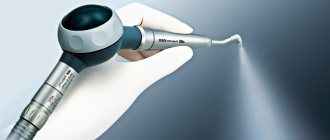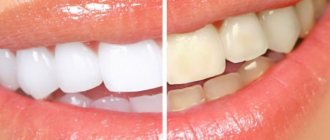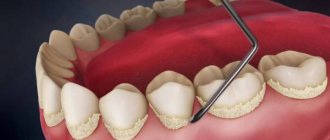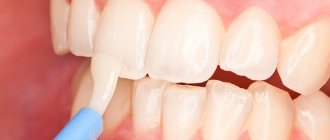Most of us rarely visit the dentist, believing that tartar – a problem of an aesthetic nature, and you can easily get rid of it by carrying out routine teeth cleaning. Unfortunately, it is impossible to remove hardened plaque on your own without the participation of a specialist. A person rarely devotes much time to oral hygiene; as a result, the resulting plaque turns into tartar, which is impossible to get rid of without the help of professionals.
If you don’t know how to remove tartar , read this article carefully, or even better, make an appointment with your dentist for the nearest date.
It's all due to poor hygiene
Hard plaque is a special mineralized film that consists of many microbes. Poor daily brushing leads to their proliferation and promotes the growth of a soft, invisible film on the teeth. It, under the influence of microflora, begins to actively mineralize within fifteen hours.
Mineralization is completed after 7 days, and after 6 months full-fledged stones appear on the bone formations. The outer protective shell of the coronal part of the tooth, which is overgrown with plaque, begins to darken, but this is not the only negative aspect: hardened plaque (dental deposits) is the main infectious center and becomes the basis for the appearance of a number of diseases, which cause many troubles, including tooth loss.
Thus, cleaning hardened plaque is not only a hygienic aspect. This procedure can be called tooth-preserving, and competent treatment at the dentist is rarely complete without it. Before: replacing a lost or irreversibly damaged tooth with an artificial implant; installation of orthodontic braces; whitening or other procedures, the specialist carefully removes the stones so that the procedure leads to a positive result.
Tartar
Dangers of tartar on teeth
If the layers are not treated in a timely manner, you may encounter a whole range of complications. Some of them can even lead to the loss of your own teeth if the symptoms are not dealt with in time.
The deposit on the teeth can be colored in different shades by natural dyes such as coffee, wine, tea, cigarette smoke, etc. But discoloration is not the whole problem; the appearance of bad breath also creates many problems due to the development of microflora.
It doesn’t matter how dense the deposit on the teeth is, but microorganisms and bacteria develop in it, which cause the development of inflammation, and as a result, damage to the gums. The sharp edges of the stone injure the gums and cause bleeding of the gums, loosening of teeth and their loss. Today it has been proven that plaque is a very strong factor contributing to the appearance of gingivitis and various other inflammatory diseases. Therefore, removing tartar from teeth can become one of the main preventive measures against various types of gum pathologies.
Caries
In the absence of treatment of the deposits, a person often faces caries. Its cause is streptococci, which soften tooth enamel. Caries is a constant source of infection in the body. It also destroys teeth.
Periodontal disease
With periodontal disease, the necks of the teeth are gradually exposed due to the influence of pathogenic microflora. This disease is fraught with early tooth loss.
Gingivitis
Gingivitis is a disease accompanied by inflammatory processes in the gum tissue. Pathology quickly leads to loosening and loss of teeth.
Periodontitis
A disease accompanied by inflammation of the tissue surrounding the tooth is called periodontitis. If treatment is not carried out on time, there will be complaints of bleeding gums and bad breath. In especially advanced cases, teeth will fall out completely.
What types of formations are there?
Is it possible to remove tartar ? It all depends on its type. Hardened dental plaque contains organic and inorganic components. About thirty percent of the components are organic: microorganisms, protein, etc., and inorganic components include calcium salt.
Hard plaque is classified according to where it accumulates. Separate the stones:
- Above the gums. They can be noticed when smiling; the shade of such plaque is dark or yellow. Removed quickly.
- Under the gums. They form under the gum and are therefore difficult to notice with the naked eye. The tooth looks completely healthy.
As a rule, such formations can be seen if you look at the gums - hard plaque makes them turn blue, swelling and bleeding appear. Stone in the space between the gum and tooth root can cause minor local suppuration.
Noticeable hardening signals a lack of hygiene, and subgingival formations are associated with a disruption of the connection between bone formation and gums, which destroys all tissues. Formations under the gum can only be detected by a dentist using special instruments. Finding them and removing them is a very difficult task, which not every specialist can handle.
If you are wondering how much it costs to remove tartar , then the price depends on its type and the complexity of the procedure. The minimum price in the CIS is 20-30 dollars.
Actions after the procedure
After ultrasound therapy, a patient with an incorrect bite must be given a pause, during which he does not put on braces.
If after the session it is planned to continue dental treatment, the patient is given several days of rest to restore areas with thinned enamel.
Then the doctor begins filling or installing dentures.
After ultrasound therapy, a patient with a malocclusion must be given a pause, during which he does not put on braces. This is also required to restore the enamel.
Also after therapy, slight bleeding of the gums is possible. In this case, the dentist takes action to stop it.
Why does it appear?
The main cause of any problem is insufficient hygiene. If you regularly cleaned your mouth poorly, did it with the wrong brush, or used a low-quality paste, then expect the formation of not only hardened plaque, but also destruction of hard tooth tissue, and other equally dangerous diseases. To avoid adverse effects, choose the right brush and toothpaste, also follow the correct technique for brushing your teeth and be sure to rinse and floss your mouth after eating.
The accelerated appearance of hardened plaque causes:
- Hobbies for confectionery, carbonated drinks, foods rich in simple carbohydrates;
- Frequent consumption of soft or liquid foods, food fillers and flavored sweeteners;
- Poor diet;
- Drinking alcoholic beverages and smoking;
- Heavy secretion of saliva;
- Taking a number of pharmacological drugs;
- Chronic inflammatory diseases.
Why do plaque and tartar form? 8 reasons worth knowing
The most common causes of stone and plaque formation are the following:
- Poor oral hygiene;
- Poor quality or incorrectly selected paste or brush;
- Abuse of carbohydrate foods (sweets, baked goods);
- Smoking;
- Frequent consumption of coffee, tea, coloring products;
- Diseases of the stomach and intestines;
- Dental malocclusion;
- Long-term use of medications (in particular antibiotics).
What is tartar?
The process of the appearance of hardened deposits begins with the formation of a slight plaque, then mineral salts accumulate on it, forming crystallization axes, and as a result, an increase in crystals contributes to the deposition of plaque, which, over time, becomes like stone.
Hardened plaque consists of 90% dangerous microbes, the proliferation of which can cause:
- Gradual destruction of hard tooth tissues.
- Unpleasant smell.
- Diseases of the oral mucosa.
- Worsening of a number of chronic diseases of the oral cavity.
- Inflammation of the mucous membrane of the gums.
- Spread of the inflammatory process to other tissues of the jaw or gums. If cleaning is not done immediately after plaque has accumulated under the gums, germs can attack the roots, leading to bone loss.
Important. By remembering this combination of words “ tartar removal dentistry ”, you will never have dental problems.
Tartar removal
How much does a good scale cleaning cost?
Today, effective removal of tartar in Moscow costs around 3,500 rubles. This amount includes:
- patient consultation with a dental hygienist;
- anesthesia (if necessary);
- use of a mouth dilator;
- removal of hardened deposits - in the sub- and supragingival zones;
- grinding of all teeth;
- recommendations for home oral hygiene and prevention.
If you go by the price list of the 32 Dent clinic, the cost of hygiene using the gentle and comfortable Air Flow method will be approximately 4900 rubles. This amount includes:
- elimination of pigmented plaque using the Air Flow device;
- grinding and polishing with dental paste;
- selection of individual products for oral hygiene and prevention tips.
All the measures that we have described relate to the powerful prevention of caries and other pathologies of the oral cavity. It is much easier, more comfortable and more profitable to perform such inexpensive and relatively simple prevention than to spend a lot of time, effort and finances on treatment in the future.
Sources:
- Personal experience as a periodontist;
- Borovsky E.V., Ivanov V.S., Maksimovsky Yu.M., Maksimovskaya L.N. Therapeutic dentistry. Textbook / - M.: Medicine, 2001;
- Grudyanov A.I., Ovchinikova V.V. Prevention of inflammatory periodontal diseases. - M., 2007;
- Danilevsky N.F., Magid E.A., Mukhin N.A., Milikevich V.Yu. Periodontal diseases. - M.: Medicine, 1993;
- Kuryakina N.V., Savelyeva N.A. Dental prevention. — M.: Med. Book N. Novgorod: Publishing house NGMA, 2003;
- Ulitovsky S.B. Oral hygiene in periodontology. - M.: Medical Book, 2006;
- Ulitovsky S.B. Encyclopedia of preventive dentistry. - St. Petersburg, 2004;
- Ed. Maksimovsky Yu.M. - Therapeutic dentistry. - M.: Medicine, 2002.
Tartar – removal
Is it necessary to remove tartar ? The answer is clear - yes!
Minor daily plaque can be easily removed through natural hygiene. The remaining dental deposits can only be removed by a dentist using special pharmacological agents. Since the last stage of hardening occurs over 6 months, you need to make an appointment with a doctor twice every 12 months so that he can monitor the condition of your teeth and gums and, if necessary, remove the stone, protecting your teeth and gums from an insoluble problem.
Remove tartar in the clinic
There are a number of professional methods for cleaning solid deposits - the basis for their choice is the amount of work and the capabilities of the dental clinic.
Types of professional teeth cleaning: Air Flow, ultrasonic, laser, etc.
- Ultrasonic teeth cleaning is one of the most popular methods of removing tartar and plaque from under the gums, as well as from the teeth themselves and in the space between the crowns. To carry out the procedure, a dental apparatus with a scaler is used, which delivers ultrasound waves, breaking hard plaque into microparticles. Remains of bacteria are washed off with water. The equipment copes with even the largest and oldest deposits, subgingival calculus, as well as the so-called “invisible” supragingival deposits.
Average duration – should be carried out up to 45 minutes.The need for anesthesia is not always necessary. In some cases, an anesthetic gel is applied to the patient's gums.
The level of discomfort during the procedure is minimal.
- Laser teeth cleaning – the procedure is carried out using a laser device. A fluoride-containing gel is applied to the teeth and a laser beam is applied, which lasts for about 15 minutes. Particles of removed plaque and stone are removed with a stream of water. The laser beam eliminates hard deposits, as well as soft plaque, the so-called “cigarette plaque”, and “complex” subgingival calculus. A gentle and painless method that allows you to achieve perfect sterility. The laser also helps strengthen gums. After the procedure, the doctor may suggest polishing the teeth, due to which the effect is achieved as if after whitening.
Average duration – should be carried out up to 30 minutes.Anesthesia is not necessary.
There is no discomfort during the procedure, it is performed silently, the patient can feel a pleasant warmth.
- Air Flow is a professional procedure that involves treating teeth and gums with abrasives and air. The actions are combined with polishing and improving the tone of the enamel (the shade changes by a couple or three tones). The Air Flow procedure can be either separate or combined with ultrasonic teeth cleaning. The Air Flow procedure is based on the operation of a special machine that supplies a strong stream of water with abrasive microparticles. As a result, it is possible to wash away plaque from the teeth themselves, as well as from under the gums, in the difficult space between the crowns. The water jet works gently and prevents overheating of tooth enamel. At the same time, a high-quality gum massage is performed, which has a beneficial effect on blood circulation and the health of the gum tissue.
The average duration of dental treatment is about 40 minutes.There is no need for anesthesia when performing Air Flow, since the procedure does not cause pain.
Discomfort – with Air Flow there is no discomfort; a noticeable result is visible immediately after cleaning by the dentist. The powder contains aromatic particles that freshen breath.
- Chemical teeth cleaning is a highly effective procedure for removing plaque and tartar using chemical reagents that dissolve formations. The method is used when, for example, ultrasonic cleaning and Air Flow cannot cope with deposits. A chemical mixture with the addition of hydrogen peroxide is applied to the old stone and washed off after a few seconds.
Average duration – should be carried out for 25 minutes.The need for anesthesia is not always necessary; in general, with a professional approach, the procedure is painless.
- Manual cleaning of plaque is a procedure without the use of devices. The method is implemented using a special tool: hooks with sharp tips, with which the dentist “catches” the subgingival stone and removes it from hard-to-reach places.
Average duration – should be carried out up to 30 minutes.Anesthesia is necessary; the gums are covered with an anesthetic gel.
There is no discomfort with the right approach; a professional dentist performs everything carefully, without injuring the teeth and gums.
Methods for removing tartar
Removal according to the “classic”
For many years, plaque deposits were cleaned using hand tools. For this purpose, hooks and hammers were used: the hardening particles were beaten off from the bone formations, particle by particle, and then cleaned. This technique was very uncomfortable for the patient and was accompanied by a sensitive outer protective shell of the tooth and damage to the soft tissue. In recent years, safe and effective ways to combat plaque have been explored, so today mechanical cleaning is considered a relic of the past.
Ultrasound removal of tartar
Advantages and disadvantages of ultrasound therapy
Thorough treatment of all root canals is the main advantage of ultrasonic teeth cleaning
The most important advantage of the service is the tangible cosmetic effect.
After the session, the patient is completely free of plaque in any part of the tooth surface. His teeth become brighter due to the whitening effect.
Unlike alternative methods of mechanical and chemical action, ultrasonic vibrations are not harmful to enamel and gums, and the procedure itself is quick and does not hurt.
Modern hardware ultrasound technologies have the following advantages:
- thorough treatment of all root canals;
- smoothing the relief surface of the enamel;
- correction of teeth shade in smokers;
- teeth whitening effect.
Unfortunately, the technique is not without a number of disadvantages:
- the presence of a large number of contraindications;
- the likelihood of mechanical injuries to dentin;
- high cost of treatment;
- Ultrasonic cleaning does not provide permanent results, so re-treatment may be required after one or two years.
The extent to which the benefits of ultrasound therapy outweigh its negative aspects depends on the professionalism of the dentist. Therefore, when making an appointment, pay attention to the reviews and qualifications of the doctor who will clean your teeth with ultrasound.
Ultrasound removal of tartar
Ultrasound has become the most popular method for combating hardened plaque today. Its use is most effective, does not harm the enamel and cleanses the entire oral cavity.
- The procedure is carried out using a special scaler apparatus. At the tip of the device there is a special metal hook, the tip of which performs rapid chaotic movements in the required ultrasonic range.
- Formations that come into contact with the moving nozzle begin to collapse, and a stream of water, which at the same time flows into the oral cavity, cleans the teeth.
- The liquid supplied to the tip of the hook cools the enamel and the device itself during operation.
- Water ultrasonic frequencies promote the formation of minimal bubbles, which release energy that destroys solid accumulations.
The entire procedure will take no more than 60 minutes and has a positive effect on the outer protective shell of the crown of the tooth.
Is it possible to brush teeth with ultrasound during pregnancy?
The best period for preventive cleaning is the second trimester of pregnancy. At this time, the child is already reliably protected by the placenta and is actively developing. Increased growth of the skeletal system provokes tooth decay in the mother, so we must try to protect ourselves as much as possible.
Ultrasonic cleaning with the addition of Air-Flow is considered by experts to be one of the best methods of prevention, as it allows you to sanitize the oral cavity as effectively as possible. The risk of caries is reduced, which allows you to simply save your teeth.
Before visiting a dentist, you must obtain permission from a gynecologist, since the decision is made individually, based on the woman’s condition.
Important. Ultrasound does not affect mother and child and does not cause allergies. The procedure is painless, and the mother feels excellent after the session.
Laser technique
Cleaning the tooth surface occurs without contact. The action of the device concerns exclusively dental plaque - neither the external nor the internal protective crown part of the tooth is affected. The principle of operation of the device is that it acts on liquid substances. The laser destroys tartar with its beam, and a stream of air and water entering the cavity washes out even the smallest particles of solid deposits.
This technique is distinguished by its effectiveness and safety, but it is not so popular due to its inflated price.
Is it painful to remove tartar ? No, modern treatment methods make it possible to carry out the procedure and make it absolutely painless.
Choosing a method
Deposits on teeth can only be removed in a dental clinic using modern techniques, such as ultrasound, powder jet, instrumental, etc.
Ultrasound method
Ultrasonic cleaning uses a so-called scaler, the tip of which creates oscillatory movements with a frequency of 25-30 thousand Hz. Thanks to this, all deposits, both hard and soft, are removed.
Air-Flow method
With the Airflow powder blasting technique, soft deposits disappear instantly. The essence of this technique is to supply a strong aerosol jet through a special thin tube. It consists of air, water and a cleaning powder that knocks down all deposits from the most remote corners and gum pockets, up to 10mm deep.
Dry cleaning
Chemical treatment of deposits is based on the use of a special composition that easily softens deposits and allows them to be removed from teeth without difficulty. The procedure has many disadvantages (for example, the likelihood of damaging enamel or soft tissue, an unpleasant taste in the mouth, the inability to cope with hard deposits), which is why it is used less and less in practice.
Mechanical cleaning
The instrumental method - curettage, is used in cases of stone deposits in the gum pockets and under the gums, when other methods are ineffective. In this case, not only deposits are removed, but also pathologically altered gum tissue.
Laser Application
Laser technology in the treatment of dental plaque has proven itself to be effective and safe. In this case, the deposit is removed layer by layer, a painless method. The disadvantage is the high price, but the treatment is suitable even if children need help.
Tartar removing toothpaste
A special paste is applied to the teeth that can soften hard formations, but not remove them. The effectiveness of toothpaste is questionable. Yes, it will undoubtedly clean your teeth and make them strong, prevent all kinds of destruction, but it will not be able to clear them of stones. Therefore, the question of where to remove tartar should not arise for you - only at the dentist.
When is it necessary to clean teeth from hard formations?
It is necessary to check with a doctor for the presence of stones on your teeth twice a year. Those who have problems with daily cleansing of the mouth, smoking, poor diet, or gastrointestinal function should be checked by a dentist once a quarter.
Before removing hardened plaque, the dentist determines whether there are contraindications to the procedure, and also eliminates disease of the teeth and gums.
Ultrasound therapy is not compatible with:
- Dental implant;
- Orthodontic structures;
- Failure of successive contractions of the heart muscle;
- Chronic inflammatory disease of the respiratory tract;
- Inflammation of the lung mucosa;
- Colds;
- Infection caused by Koch's bacillus;
- Inflammatory liver diseases;
- Increased sensitivity of tooth enamel;
- The first three months of pregnancy.
Laser should be avoided if:
- You are under eighteen years of age;
- You are expecting a baby or are breastfeeding;
- You wear braces;
- You are the owner of very sensitive enamel;
- There are many teeth with fillings in the mouth;
- You suffer from cardiovascular diseases, viral or infectious diseases.
When is it not recommended to brush your teeth?
This method of hygiene should be abandoned during pregnancy and breastfeeding, as well as in case of kidney disease and tuberculosis. The procedure should be carried out extremely carefully (or not at all) in cases of depleted and very thin tooth enamel, extensive caries lesions, viral diseases, immune pathologies, as well as in cases of diseases in the acute stage (for example, bronchitis, tonsillitis, etc.). Allergy to medications is also considered a contraindication for cleaning (for example, when performing Air Flow cleaning).
Removing stones at home
Today you can read various recipes online, following which, it seems, you can cleanse your teeth of unwanted formations without the help of a specialist. In addition to the fact that they will not bring the desired effect, such methods can additionally injure the teeth and cause additional harm to them. The use of soda or mineralized salt is not considered the best folk remedies. Cleaning teeth from stones is the task of professionals in their field. The only thing you can do is to follow preventive measures and prevent stones from appearing.
Service cost
Offers for dental correction with ultrasound are provided in private dental clinics. It is not included in the mandatory list of free procedures.
The average cost of one course varies between 1500-3000 rubles. The difference in price is due to the marketing policy of dentistry and additional actions, for example, the need for anesthesia.
In addition to complete cleaning, you can order cleaning of one or more teeth. In this case, you will have to pay from 100 to 150 rubles to clean each one.
Prevention of tartar
Preventing soft plaque from turning into hard plaque is not that difficult. To do this you need:
- Visit a licensed dentist once a quarter.
- Purchase the right and high-quality hygiene products.
- It is best to ask your doctor to recommend a cleansing powder and brush; you can also pay attention to other means of cleaning the oral cavity, if necessary (herbal rinses, irrigators).
- Reduce the amount of junk food and drinks that are harmful to your teeth.
- Diversify your diet with vegetables and fruits.
- Give up cigarettes.
- Eliminate all dental diseases immediately after diagnosing them.
- Monitor your health status and take the necessary tests once a year.
If plaque forms abnormally quickly, this may indicate a problem with the gastrointestinal tract and metabolic processes in the body. In this case, going to the dentist will only bring a short-term effect, and the problem cannot be solved in this way until the source of the problem is eliminated
Is it painful to brush your teeth with ultrasound?
The procedure is considered painless, but may cause some discomfort if the enamel is sensitive. If the patient has a high pain threshold, he may well do without anesthesia. But in most cases, the dentist applies a special gel to the surface of the teeth. Also, applying water to the tooth when exposed to a scaler helps reduce pain.
Stone removal with 20% discount
Moscow
Will my teeth hurt after brushing?
No, no and NO. On the contrary, all patients, without exception, note extraordinary freshness in their mouth after the procedure. If you can say – even a feeling of lightness. The removed deposits do not put pressure on the enamel, and the feeling of tension in the teeth disappears.
When exposed to a scaler and a water-abrasive mixture under pressure, the gums are massaged. Blood circulation is normalized in the soft tissues, which also provides noticeable comfort in the mouth.
In general, ultrasonic cleaning is great. Having done it at least once, you will come to the dentist once every six months as required. Please note, come with pleasure.
Tartar removal – cost of the procedure
The cost of cleaning teeth from hard plaque is significantly influenced by the price range of the dental clinic. Modern equipment and the professionalism of a qualified doctor, but you pay for a safe procedure with high-quality products. Also, the final cost depends on the severity of the work and its volume.
It happens that it is not possible to limit oneself to classic cleansing and it is necessary to treat inflammatory processes on the gums, clean the space between the gum and the tooth root, etc.
To clean your teeth from hardened plaque you need to have at least $40. Your doctor will tell you the final cost during your consultation.
Remember that for such a nominal fee you will receive a perfect smile and clean teeth that will delight you with your health.
Existing contraindications
Contraindications to the treatment of deposits are not as extensive as one might think. Treatment is not carried out only in cases where the patient is in an exacerbation of any chronic disease or advanced oncology has been identified. Also, treatment is not carried out in the acute phase of the inflammatory process, during the period of active colds.
Consultation and diagnostics
Making a treatment plan
Treatment procedure
Preventive examination
What are the benefits of a therapeutic and cosmetic session?
The correction procedure has a multifaceted beneficial effect:
- Under the influence of an ultrasonic wave, hard foreign deposits are broken down over the entire surface, including the space under the gums. This result is not available using similar methods.
- Along with the cleansing effect, the enamel whitens, which acquires a natural shade - softer and more natural than after other corresponding procedures.
- After cleaning with the device, the doctor will be able to quickly identify pathologies of the tissues of the interdental space and gums.
- The procedure is painless and much faster than other methods.
- Cleaning helps during periodontal treatment and fillings. It is often recommended to remove deposits before prosthetics.
These are only the main results that can be achieved after completing the course of treatment. The beneficial qualities of the procedure are not limited to this.











